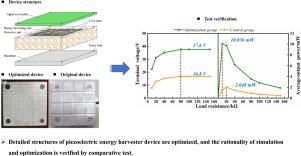Sensors and Actuators A: Physical ( IF 4.6 ) Pub Date : 2020-09-03 , DOI: 10.1016/j.sna.2020.112322 Chaohui Wang , Gongxin Yu , Hongyun Cao , Shuai Wang , Yanwei Li

|
The structure of piezoelectric energy harvester device has a significant impact on electromechanical conversion performance, and appropriate structural parameters are the important premise to ensure electromechanical conversion efficiency. In order to design the detailed structures which are more conducive to the electromechanical conversion in the d33 mode, and optimize or enhance the mechanical response of the piezoelectric energy harvesting unit, a finite element model was established to comprehensively analyze the influence of the detailed structures on the electromechanical response of the energy harvesting unit, based on the results, optimal detailed structural parameters are determined, and lateral mechanical environment of the energy harvesting unit is optimized. Finally, the stacked piezoelectric energy harvester device for road is made, and the rationality of optimization is verified by the MTS indoor comparative test. The results show that the protective pad with a fillet size of 3 mm, a thickness of 3 mm and an elastic modulus of 8000∼15000 MPa can effectively avoid edge stress concentration and obtain maximum top compressive stress for the energy harvesting unit, and also ensure durability and electrical output. Compared with the baseplate, the influence of the upper cover plate on electrical output is more significant, and the elastic modulus of the upper cover plate should be less than 2000 MPa, the thickness should be controlled within 8∼10 mm. The potential difference generated by the energy harvesting unit in lateral constraint environment is 40 % lower than that in no lateral constraint. Under load of 0.7 MPa-10 Hz, the terminal voltage of the optimization group is 2.2 times that of the control group, the average output power is 4.9 times, and the power density is 2.7 times, which shows the optimization rationality of detailed structures.
中文翻译:

道路压电能量采集器装置的结构仿真优化与试验验证
压电能量收集器装置的结构对机电转换性能有重大影响,适当的结构参数是保证机电转换效率的重要前提。为了设计更有利于d 33中机电转换的详细结构模式,并优化或增强压电能量采集单元的机械响应,建立了有限元模型,以综合分析详细结构对能量采集单元的机电响应的影响,基于结果,获得最佳的详细结构参数确定,并优化能量收集单元的侧向机械环境。最终,制造出了用于道路的堆叠式压电能量收集器装置,并通过MTS室内对比测试验证了优化的合理性。结果表明,圆角尺寸为3 mm,厚度为3 mm,弹性模量为8000〜15000 MPa的保护垫可以有效避免边缘应力集中,并获得能量收集单元的最大顶部压缩应力;并确保耐用性和电力输出。与底板相比,上盖板对电输出的影响更大,上盖板的弹性模量应小于2000 MPa,厚度应控制在8〜10mm以内。能量收集单元在横向约束环境下产生的电势差比没有横向约束条件下的电势差低40%。在0.7 MPa-10 Hz的负载下,优化组的端电压为对照组的2.2倍,平均输出功率为4.9倍,功率密度为2.7倍,说明了详细结构的优化合理性。上盖板的弹性模量应小于2000 MPa,厚度应控制在8〜10 mm以内。能量收集单元在横向约束环境下产生的电势差比没有横向约束条件下的电势差低40%。在0.7 MPa-10 Hz的负载下,优化组的端电压为对照组的2.2倍,平均输出功率为4.9倍,功率密度为2.7倍,说明了详细结构的优化合理性。上盖板的弹性模量应小于2000 MPa,厚度应控制在8〜10 mm以内。能量收集单元在横向约束环境下产生的电势差比没有横向约束条件下的电势差低40%。在0.7 MPa-10 Hz的负载下,优化组的端电压为对照组的2.2倍,平均输出功率为4.9倍,功率密度为2.7倍,说明了详细结构的优化合理性。


























 京公网安备 11010802027423号
京公网安备 11010802027423号